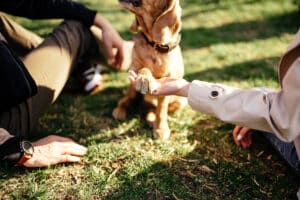Understanding Autism in Dogs
Autism is generally associated with humans, but discussions about autism in dogs have been gaining attention. While the exact terminologies and diagnostics differ, dogs can exhibit repetitive behaviors and social challenges that mirror symptoms of autism spectrum disorder in humans. These patterns raise questions about whether dogs experience a condition similar to human autism.
Dogs that exhibit repetitive behaviors, hyper fixation, or a lack of social interaction with other dogs might display what some refer to as canine dysfunctional behavior. This observation can help dog owners better understand their pets’ unique needs and behaviors.
Success Stories
“Move Up ABA has been a lifeline for our family. Before starting therapy, our son struggled with daily routines and communication. Now, he’s more independent and even initiated a conversation with a classmate for the first time! The progress we’ve seen in just six months is truly remarkable.”
- Emily R., Silver Spring, Accountant
“As a single dad, I was overwhelmed trying to manage my child’s behavior. The Move Up ABA team not only provided amazing support for my little girl but also taught me practical strategies to use at home. Their in-home sessions fit perfectly with our busy schedule. I’m so grateful for their patience and expertise.”
- Michael T., Rockville, Middle School Teacher
“We were hesitant about starting ABA therapy, but Move Up ABA’s approach put us at ease from day one. Our twins have made incredible strides in their social skills and self-regulation. The therapists are like extended family now, and we couldn’t be happier with our decision to work with them.”
- Aisha and James L., Simpson, Police Officers
Ready to start your child's journey to success? Schedule a free consultation today! 📞 Call (410) 497-8865.
What is Canine Dysfunctional Behavior?
Canine dysfunctional behavior refers to a set of abnormal behaviors observed in pet dogs, including sensory sensitivities, social withdrawal, and repetitive actions. These behaviors may not align with typical canine behavior and could signal that the dog is experiencing environmental or internal stressors.
For dog owners, recognizing signs of dysfunctional behavior is essential. Dogs exhibiting behaviors such as tail-chasing, prolonged staring, or lack of interaction with their owners might require special attention and care to ensure their overall well-being.
Similarities Between Autism Spectrum Disorder and Canine Behavior

When examining canine autism, it’s important to draw parallels cautiously. Autism spectrum disorder (ASD) in humans is a complex neurodevelopmental disorder and cannot fully translate to animal behaviors. However, dogs may show repetitive actions or diminished interest in social interaction, which could resemble human autism characteristics.
These autism-like symptoms, though not equivalent to ASD, may hint at underlying canine behavioral patterns. These behaviors often impact genetics, environmental influences, and overall health.
Repetitive Behaviors in Dogs
One prominent sign associated with autism-like symptoms in dogs is repetitive behaviors. Dogs that exhibit repetitive behaviors, such as constant chasing of tails, pacing, or licking objects, might appear to mirror the stereotypical actions seen in autistic children.
Tracking these patterns can help dog owners identify quirky habits versus potential issues. It might indicate an underlying problem when excessive certain behaviors interrupt regular routines.
Canine Sensory Sensitivities
Sensory sensitivities are another characteristic that can point toward canine behavioral issues. A dog may overreact to bright lights, loud noises, or physical touch, appearing distressed during ordinary situations.
Understanding these reactions can allow owners to create a more accommodating environment. Gradually introducing sensory stimuli while paying close attention to the dog’s comfort can improve their daily experiences.
Role of Environmental Factors
Environmental factors significantly influence a dog’s behavior. Loud, chaotic surroundings or a stressful lifestyle can exacerbate problems in dogs predisposed to such conditions. Calm and structured environments often help reduce negative behaviors.
Dog owners can take proactive steps by ensuring their pets have safe, consistent, and enriching surroundings. Doing so may prevent the escalation of undesirable behaviors, fostering a happier and more balanced relationship between the dog and owner.
The Concept of Autistic Dogs
While research on autistic dogs remains limited, the term “autistic dog” is often used to describe pets showing unusual, dog’s exhibit autism like behaviors. By observing their dog’s behavior, owners might notice social withdrawal or an inability to interact naturally with other dogs.
It’s important to approach these observations with empathy and patience. Consulting a veterinarian or a canine behaviorist can help clarify whether the dog is unique or experiencing a behavioral condition. By observing behavioral patterns, owners can gain better insight into their pet’s needs and address any underlying issues effectively.
Behavioral Similarities With Autistic Children
Dogs with autism-like behaviors and autistic children often share overlapping challenges. Both may struggle with social interactions and exhibit repetitive actions. Recognizing these behaviors in dogs can help draw parallels when considering how to meet their needs.
Providing a supportive and structured environment aids in handling such behaviors. This approach benefits the dog and deepens the bond between the dog and its owner.
How Dog Owners Can Help

Dog owners play an essential role in managing their pets’ autism-like symptoms. The first step is to closely observe changes in a dog’s behavior. Supportive techniques, including positive reinforcement training, can help encourage desirable habits while curbing problematic ones.
Maintaining a consistent routine and reducing stressors can improve the dog’s quality of life and relationship with their owner. Every effort counts when helping a pet thrive.
Are There Treatments for Canine Autism?
While there is no definitive cure or diagnosis for canine autism, several approaches can be taken to manage symptoms and provide supportive care. Behavior modification training and environmental adjustments often work best for dogs exhibiting repetitive or socially withdrawn behaviors.
Veterinary guidance is key, as a professional can rule out other medical conditions causing similar symptoms. Early intervention can significantly improve a dog’s behavior and overall happiness.
Social Interaction Challenges in Dogs
Some dogs may avoid playing with other dogs or engaging with humans. This behavior could signal underlying socialization difficulties that are pivotal in understanding canine behavioral conditions.
Building trust is essential in these situations. Dog owners should introduce social activities slowly, rewarding positive interactions to encourage better behavior and social engagement.
Observing Autism-Like Symptoms in Dogs
Dogs exhibiting autism-like symptoms often display unique behavioral traits. They might seem uninterested in stimuli that usually excite other dogs or repeatedly perform specific movements like paw-licking or circling.
These actions serve as important signals for dog owners to investigate further. Thoroughly observing daily patterns can help owners determine whether a visit to a specialist or veterinarian is necessary.
The Role of Genetics in Canine Behavior
Genetics can be a potential factor in a dog’s behavior. Certain breeds, such as Bull Terriers, may display more repetitive behaviors or sensory sensitivities, hinting at a genetic predisposition towards such conditions.
Understanding a dog’s breed and genetic history empowers owners to tailor care and training approaches to fit the pet’s unique needs.
Building Awareness Around Autism in Dogs
With an increased understanding of how dogs exhibit behaviors resembling autism spectrum disorder, dog owners can take proactive measures to provide the best care. Awareness fosters compassion for pets facing unique behavioral challenges.
Learning about autism in dogs enhances the human-animal bond. A dedicated effort to support and cater to these needs ensures a fulfilling life for the dog and the owner.
Recognizing Early Signs in Puppies

Identifying early behavioral traits in puppies can help address potential concerns like humans. Puppies demonstrating a consistent lack of interest in engaging with their environment or peers may benefit from closer monitoring.
Early intervention can pave the way for better management techniques. Observing these behaviors during puppyhood allows owners to provide tailored care that supports the puppy’s development.
The Importance of Routine for Behavioral Stability
Dogs thrive on consistency, and maintaining a routine can alleviate behavioral challenges. Regular feeding, exercise, and play schedules contribute to a sense of security and reduce anxiety in dogs with sensitivities.
Predictable environments help ease confusion and stress. When dogs know what to expect, they are more likely to feel comfortable and confident in their surroundings.
Enhancing Communication With Dogs
Effective communication with dogs is critical to understanding their needs and addressing behavioral conditions—body language, vocal tones, and consistent commands bridge mutual understanding.
Patience is crucial in building this connection. Clear, gentle communication helps establish trust and promotes cooperative behavior in the long term.
Mental Stimulation for Dogs With Unique Needs
Mental stimulation is as essential as physical exercise for dogs with autism-like behaviors. Puzzle toys, obedience training, and interactive play provide a healthy outlet for their energy.
Enriching their mental world can help reduce repetitive behaviors. These activities also strengthen the bond between the dog and the owner.
Addressing Sensory Overload in Dogs
Sensory overload can be distressing for dogs with heightened sensitivities. Loud noises or chaotic environments may cause them to withdraw or act out.
Creating quiet spaces in the home provides a sanctuary for such dogs. These spaces offer a temporary retreat during overwhelming situations, helping them feel safe.
Encouraging Positive Social Interactions
Positive socialization shapes how dogs interact with their environment and others. Gradually introducing them to new people or pets can build social confidence over time.
Rewarding good behavior during interactions reinforces trust and companionship. A slow and steady approach works best when fostering relationships for socially withdrawn dogs.
Physical Activity and Its Role in Behavior Management
Adequate physical exercise helps channel a dog’s energy constructively. Walks, agility training, and playtime improve health and reduce stress-related behaviors.
Well-balanced activity routines can boost a dog’s overall happiness. Giving them structured outlets for their energy cultivates calm and positive behavior.
Nutrition’s Impact on Behavior
A dog’s diet directly influences their mood and energy levels. Nutritional deficiencies can sometimes exacerbate behavioral challenges, making proper diet planning essential.
Consulting a veterinarian ensures your pet’s diet meets its unique needs. This step contributes to better emotional resilience and overall wellness.
Emotional Support for Dogs With Autism-Like Traits
Just like humans, dogs benefit greatly from emotional support. Providing reassurance during stressful periods helps them feel secure and calm.
Regular cuddles and gentle handling reinforce a sense of safety. These small gestures can significantly improve their emotional well-being.
Training Techniques for Dogs With Autism-Like Behaviors
Positive reinforcement-based training methods are highly effective for dogs with unique behavioral challenges. Rewarding good actions motivates dogs to learn without fear.
Consistency in training leads to tangible improvements over time. It allows dogs to build confidence in their ability to adapt and thrive.
Developing Tolerance for Change
Many dogs with sensitive personalities struggle with changes in routine or environment. Exposing them to small, gradual changes helps build their adaptability.
Reassurance during transitions minimizes stress. Preparing them for unfamiliar experiences develops their ability to manage the unexpected.
Role of Play in Emotional Balance
Playtime is essential for fostering emotional stability. Engaging in playful activities reduces stress and strengthens the bond between the owner and the dog.
Interactive games also provide excellent opportunities for mental stimulation. These joyful moments contribute to a balanced and happy life for your pet.
Consulting Specialists for Behavioral Guidance
Seeking professional advice from veterinarians or canine behaviorists can uncover the root cause of unique behaviors. Specialists are equipped to recommend tailored care plans and interventions.
Early consultation prevents behaviors from escalating into more significant challenges. Their guidance ensures you and your pet are on a positive path forward.
The Journey to Understanding Canine Autism
Understanding autism-like behaviors in dogs is a continuous learning process. Every dog is unique, and their needs vary greatly depending on their temperament and environment.
When owners dedicate time and effort to understanding their pets, profound connections form. This mutual understanding fosters a harmonious life for the dog and the owner.
Building Confidence Through Routine
P
Gradually adding small variations to their routine can also improve adaptability. For instance, introducing new experiences like walking a different route or playing a new game gently pushes their comfort zone. This approach builds resilience while maintaining their sense of stability.
The Importance of Gentle Grooming
Grooming sessions can be a soothing experience for dogs when done with patience and care. Brushing their fur gently or giving them a warm bath can provide comfort and bonding opportunities. Grooming is also essential for their overall health, keeping their coat and skin in good condition.
To create positive associations, grooming tools should be introduced slowly. Offering praise or treats during the process further reinforces good behavior. Taking small steps ensures that grooming becomes an enjoyable part of their routine.
Using Technology-Free Calming Methods
Simple methods like calming music or aromatherapy can work wonders for dogs facing heightened sensitivities. Soft melodies have been found to relax dogs during tense situations by creating a peaceful ambiance. Introducing familiar scents like lavender into their environment may also help ease their nerves.
It’s important to observe the dog’s reactions and choose what works best. Every dog is unique; some may prefer quiet surroundings over additional stimuli. Tailoring these methods to their needs promotes relaxation and emotional balance.
The Value of Owner Empathy
Empathy plays a decisive role in understanding and supporting dogs with unique behaviors. Taking the time to recognize their triggers and respecting their boundaries fosters trust. Dogs can sense their owners’ emotional energy, and a calm, supportive demeanor reassures them during difficult times.
Learning to interpret subtle cues, like body language or vocalizations, provides deeper insight into your dog’s feelings. This understanding nurtures an unspoken bond that strengthens over time, creating a relationship built on mutual respect and care.
The Importance of Routine and Structure
Maintaining a consistent daily routine is incredibly beneficial for dogs with autism-like traits. Predictability helps reduce stress and anxiety, creating a sense of security in their environment. Regular mealtimes, walks, and play sessions ensure they know what to expect.
Structured schedules also allow owners to monitor behavioral changes more effectively. A consistent routine makes identifying what works best for the dog easier and adjusting care strategies accordingly. This structure is a key component in ensuring their well-being.
Celebrating Small Victories
Acknowledging and celebrating small milestones in your dog’s progress is crucial. Whether your dog is learning a new command or showing improved social behavior, these moments signify growth and adaptation. Positive reinforcement during these achievements boosts your dog’s confidence.
Progress may be gradual, but each step forward strengthens the bond between the dog and its owner. Celebrating these victories fosters a supportive environment where dogs can thrive and enjoy a better quality of life.
Conclusion
Caring for a dog with autism-like behaviors is a rewarding but thoughtful process. Owners can provide the support these unique dogs need by fostering patience, understanding, and consistency. Each effort contributes to building a happier life for the dog and its family.
Through mutual trust and small, meaningful steps, every dog has the potential to flourish in its own way. With compassion at the heart of the journey, the rewards are immeasurable.







